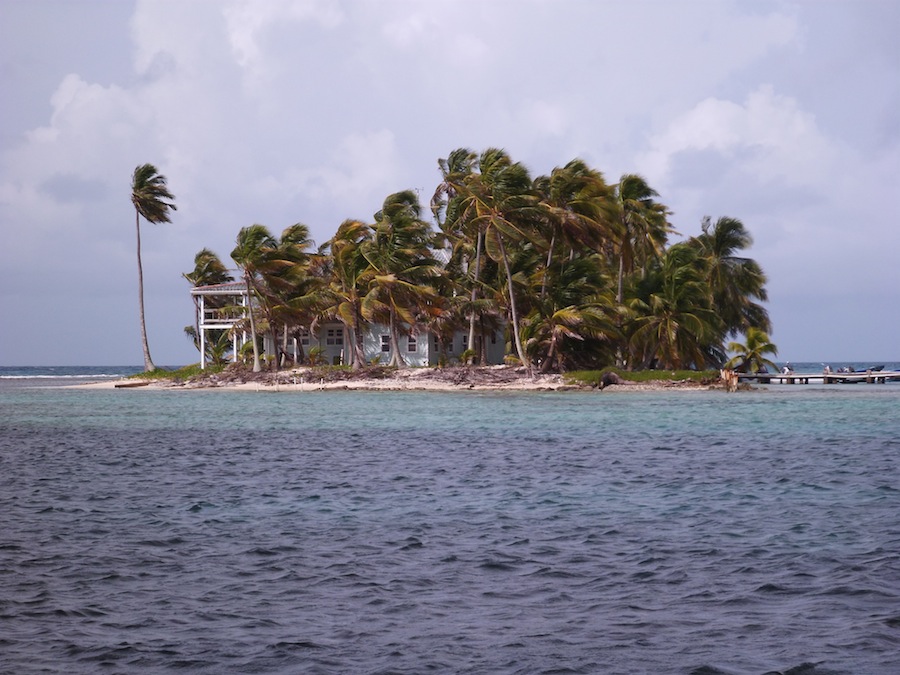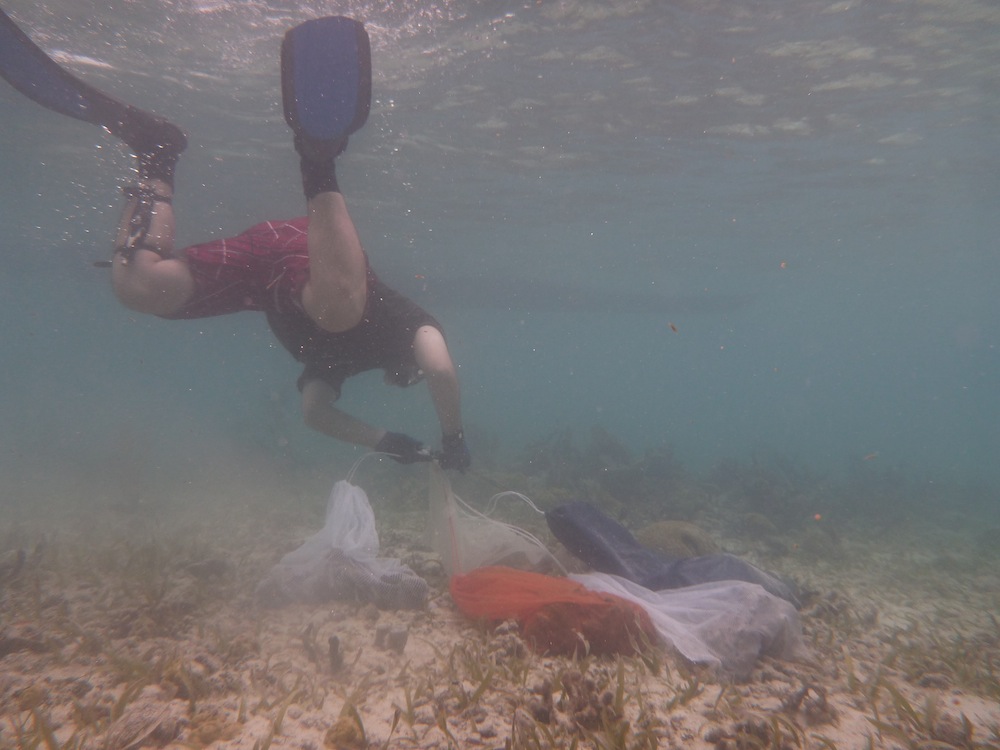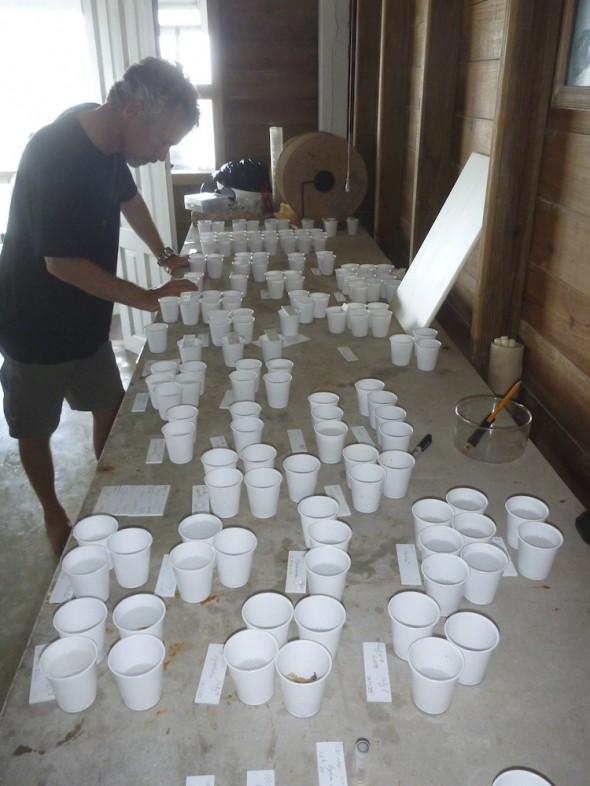
[The second installment in our New York Times “Scientist at Work” field log.]
Wednesday, July 4
Our hunt yesterday produced a good haul of shrimp species, but, alas, none of the social ones we’re searching for. I worked with my former Ph.D. student, Tripp McDonald, long into the night identifying the shrimp. Though little known to most people, they are like old friends to us, since we described and named many of the species around the island. Identifying these shrimp is no small task. There are dozens of species, many of them very similar, so it requires a good microscope, a steady hand and a great deal of patience to identify the subtle features that distinguish one from another, ranging from a subtle spine on the antennae to the color of a female’s eggs. To our great surprise, instead of the big colonies of social shrimp that usually dominate this environment, most of what we uncover are asocial pair-formers. The few social colonies that we do find are of a single species and much smaller than usual.
Today, we head farther south, hoping for a more productive patch of reef. The rings of turquoise water above shallow white sand, dotted with darker coral patches, make the sand-bore reefs easy to spot against the deeper blue water as we approach, and the surf crashing against the exposed reef crest betrays them from a distance. Dozens of these patch reefs stud the lagoon behind the barrier reef, making navigation tricky. Some of the small reefs have vigorous thickets of coral, including the elkhorn and staghorn corals that once dominated reefs throughout the Caribbean, but declined precipitously in the 1970s. Others are clothed in soft corals and sea fans or short forests of brown seaweeds. I am surprised and delighted that the reefs seem much healthier than I remember seeing them, perhaps at any time in the last 24 years. This is great news for the Belizean reefs, but makes our hunt for dead coral rubble harder than it used to be. Probably as a result, the sponges we need are proving especially elusive.
We spend the rest of the day reconnoitering the sand bores by plunging in and sizing up a reef quickly, then moving on if necessary, collecting rubble, and picking sponges. Although we manage to complete our rounds, the muffled thunder rumbling in from offshore keeps us on edge. In the end, it seems a fitting way to spend the Fourth of July — no fireworks, but plenty of lightning to brighten up the skies. Working in the field brings us back to a bygone era when the rhythms of the earth and sea dictated the smallest details of daily activities. We are constantly attuned to the horizon, the freshness and direction of the wind, the motion of the water. Although the current is stiff in places, and the surge challenges our snorkeling skills on the shallow reef tops, we don’t complain about the weather — especially on hearing from family about the record triple-digit temperatures back on the East Coast of the United States.

The next day is more of the same. We explore deeper into the sand bores, sometimes following local fishermen as a clue to finding promising reefs. A characteristic fishing industry here in the cays involves a modest sailboat packed with up to 10 men, trailing a fleet of tiny dugout canoes that disperse each morning. With only face masks and perhaps fins, pairs of men paddle off from the mother boat each morning to scour the reef for lobster and conch by skin diving. The efficiency of these low-tech crews, and the burgeoning shrimp farms clearing the mangrove forest on the mainland, give us some sobering reflection about where the seafood we eat comes from.
By evening, a pattern starts to emerge in our collections: several of the sponges most often found around Carrie Bow over the past two decades are proving impossible to find, whereas others we had rarely seen are now quite common. Social shrimp are very scarce. These results strike a discordant note, the misfit between expectation and observation, that is the germ of all scientific progress: What’s going on? We came to Belize because it was the mecca of Synalpheus social diversity, yet now we can’t turn one up anywhere in the neighborhood. And even the few social species we do find are living in tiny colonies, sometimes just in pairs. Paradoxically, despite the dearth of social shrimp, the reef looks healthier than ever; the corals appear to be thriving and reef fishes are as plentiful and diverse as we’ve ever seen them here.
Much of science is trying to understand the world around us — what distinguishes it is its systematic, evidence-based approach to determining cause and effect. Whether it’s physicians trying to determine how a virus works, or ecologists striving to understand how ecosystems function, science is about observing nature carefully and attempting to decipher how and why it works the way it does.

Over the traditional rum and tonic at day’s end, we brainstorm about what could be going on around Carrie Bow. Ecosystems are never static — they are constantly changing, sometimes suddenly. That is particularly true of coral reefs globally in recent decades. Between the warming seas that lead to coral bleaching, spreading diseases, more frequent hurricanes in many areas, and overfishing globally, reefs are under unprecedented stress. Perhaps we’re seeing a knock-on successional shift in the sponges and shrimp resulting from these more conspicuous changes in the foundation of corals. Much like a lawn that reverts to weeds, bushes and eventually trees if left fallow, the sponges around Carrie Bow could be progressing through a similar succession before our eyes as the corals on which they depend change. In this case, what’s good for the corals may be less so for the shrimp, whose host sponges appear to thrive in dead coral of a certain age. Thus, several of the sponges preferred by social shrimp are now rare, apparently replaced by other, less hospitable species. Documenting such a change with certainty requires systematically sampling from many locations for comparison with past collections.
As the discussion goes on, we become excited about trying to solve this new puzzle, but also concerned about whether we have enough time to pull it off. This illustrates another fundamental element of science — the ability to shift gears, even change your mind entirely, based on new observations. Can we figure this out, or begin to? Time is short and our targeted rubble sampling will need to be done more systematically for the rest of the trip.
Leave a Reply